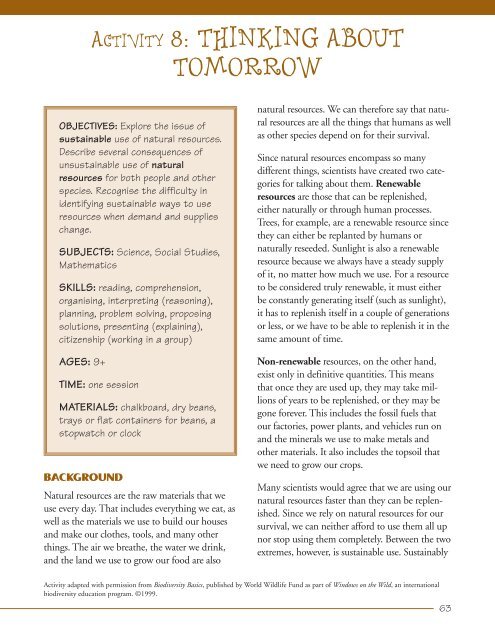EXPLORING BIODIVERSITY: A Guide for Educators Around the World
EXPLORING BIODIVERSITY: A Guide for Educators Around the World
EXPLORING BIODIVERSITY: A Guide for Educators Around the World
You also want an ePaper? Increase the reach of your titles
YUMPU automatically turns print PDFs into web optimized ePapers that Google loves.
ACTIVITY 8: THINKING ABOUT<br />
TOMORROW<br />
OBJECTIVES: Explore <strong>the</strong> issue of<br />
sustainable use of natural resources.<br />
Describe several consequences of<br />
unsustainable use of natural<br />
resources <strong>for</strong> both people and o<strong>the</strong>r<br />
species. Recognise <strong>the</strong> difficulty in<br />
identifying sustainable ways to use<br />
resources when demand and supplies<br />
change.<br />
SUBJECTS: Science, Social Studies,<br />
Ma<strong>the</strong>matics<br />
SKILLS: reading, comprehension,<br />
organising, interpreting (reasoning),<br />
planning, problem solving, proposing<br />
solutions, presenting (explaining),<br />
citizenship (working in a group)<br />
AGES: 9+<br />
TIME: one session<br />
MATERIALS: chalkboard, dry beans,<br />
trays or flat containers <strong>for</strong> beans, a<br />
stopwatch or clock<br />
BACKGROUND<br />
Natural resources are <strong>the</strong> raw materials that we<br />
use every day. That includes everything we eat, as<br />
well as <strong>the</strong> materials we use to build our houses<br />
and make our clo<strong>the</strong>s, tools, and many o<strong>the</strong>r<br />
things. The air we brea<strong>the</strong>, <strong>the</strong> water we drink,<br />
and <strong>the</strong> land we use to grow our food are also<br />
natural resources. We can <strong>the</strong>re<strong>for</strong>e say that natural<br />
resources are all <strong>the</strong> things that humans as well<br />
as o<strong>the</strong>r species depend on <strong>for</strong> <strong>the</strong>ir survival.<br />
Since natural resources encompass so many<br />
different things, scientists have created two categories<br />
<strong>for</strong> talking about <strong>the</strong>m. Renewable<br />
resources are those that can be replenished,<br />
ei<strong>the</strong>r naturally or through human processes.<br />
Trees, <strong>for</strong> example, are a renewable resource since<br />
<strong>the</strong>y can ei<strong>the</strong>r be replanted by humans or<br />
naturally reseeded. Sunlight is also a renewable<br />
resource because we always have a steady supply<br />
of it, no matter how much we use. For a resource<br />
to be considered truly renewable, it must ei<strong>the</strong>r<br />
be constantly generating itself (such as sunlight),<br />
it has to replenish itself in a couple of generations<br />
or less, or we have to be able to replenish it in <strong>the</strong><br />
same amount of time.<br />
Non-renewable resources, on <strong>the</strong> o<strong>the</strong>r hand,<br />
exist only in definitive quantities. This means<br />
that once <strong>the</strong>y are used up, <strong>the</strong>y may take millions<br />
of years to be replenished, or <strong>the</strong>y may be<br />
gone <strong>for</strong>ever. This includes <strong>the</strong> fossil fuels that<br />
our factories, power plants, and vehicles run on<br />
and <strong>the</strong> minerals we use to make metals and<br />
o<strong>the</strong>r materials. It also includes <strong>the</strong> topsoil that<br />
we need to grow our crops.<br />
Many scientists would agree that we are using our<br />
natural resources faster than <strong>the</strong>y can be replenished.<br />
Since we rely on natural resources <strong>for</strong> our<br />
survival, we can nei<strong>the</strong>r af<strong>for</strong>d to use <strong>the</strong>m all up<br />
nor stop using <strong>the</strong>m completely. Between <strong>the</strong> two<br />
extremes, however, is sustainable use. Sustainably<br />
Activity adapted with permission from Biodiversity Basics, published by <strong>World</strong> Wildlife Fund as part of Windows on <strong>the</strong> Wild, an international<br />
biodiversity education program. ©1999.<br />
63

















